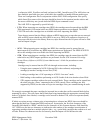/var/hpss/etc/AML_EjectPort.conf and /var/hpss/etc/AML_InsertPort.conf. The AML robot can
have multiple insert and eject ports, which have the capability to handle different media types.
These two configuration files in conjunction with the AMU AMS configuration files specify
which Insert/Eject areas or bins the tapes should be placed in for insertion into the archive and
the area to which they are ejected when the HPSS export command is used.
The AML PVR is supported by special bid only.
• LTO - When importing new cartridges into HPSS, the cartridges must be entered into the IBM
3584 input/output (I/O) station before any HPSS import operations are performed. The HPSS
LTO PVR moves the cartridges into an available slot while importing into HPSS.
Tapes that are entered into the library without an HPSS import step or tapes that are not removed
after an HPSS export should not affect HPSS in any way; HPSS will continue to function as if
these tapes did not exist in the library. However, tapes inserted into the I/O ports will not be filed
until an import is begun.
• SCSI – When importing new cartridges into HPSS, the cartridges must be entered into an
input/output (I/O) slot before any HPSS import operations are performed. The HPSS SCSI PVR
moves the cartridges into an available slot while importing into HPSS.
• STK - When importing new cartridges into HPSS, the cartridges must be entered into the STK
robot before any HPSS import operations are performed. See the STK Automated Cartridge
System Library Software (ACSLS) System Administrator’s Guide for procedures to enter
cartridges.
Cartridges may be entered into the STK silo through various means, including:
• Using the enter command of ACSLS (StorageTek's robot software) and putting the
cartridge(s) into the Cartridge Access Port (CAP).
• Loading a cartridge into a CAP operating in ACSLS's “hot enter” mode.
• Bulk loading a robot and then performing an ACSLS audit of the slots that have been filled.
• STK supports cartridges without bar code external labels. These cartridges can be entered into
the robot using the ‘venter’ command at the ACSLS console. These cartridges are fully
supported by HPSS, but the robot will eject the cartridges if they are scanned during an audit.
We strongly recommend that tape cartridges be imported into a robot that verifies external labels before
mounting in a drive. This will ensure that a blank tape being imported has the appropriate external label
before it is labeled. Once labeled, a cartridge can be moved to another PVR, such as an operator (hand)
mounted PVR.
If labels are written on tape volumes prior to importing those volumes into HPSS, then care should be
taken that the label has a format that HPSS can process. In particular, the first four characters of the
OwnerID field should be “HPSS” and the last two characters of this fourteen character field should be
“00”. HPSS uses the last two characters to indicate the side number of the cartridge in anticipation of
supporting cartridges that have multiple physical sides - e.g., optical disk cartridges that contain an A and
a B side. If these two characters are not set correctly, then the import will fail because the side
HPSS Management Guide November 2009
Release 7.3 (Revision 1.0) 224


















